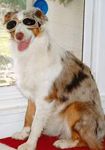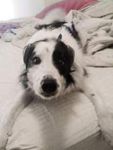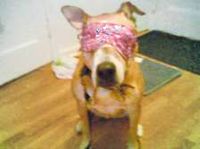Noise reactivities and phobias in dogs: Behavior modification strategies
How to recognize problems and implement appropriate client interventions.
In dogs, excessive reactions to sudden noises, such as those produced during thunderstorms, are relatively common. But not all canine responses to storms and other loud noises, including fireworks, are the same. For example, some involve greater vigilance and reactivity, others involve avoidance behaviors or fear and some are indicators of outright panic.
A fear response may include perfectly normal fearful behaviors but in a context in which they're inappropriate. For example, a dog retreating from a snake may exhibit both appropriate and adaptive behavior. Dogs that live in regions with venomous species may be on the alert for snakes and shy away from them when they see movement associated with them. This same behavior may occur if grass moves because someone stepped on a stick simply because the movement was similar enough to look like a moving snake. Here, the dog's behavior is a mistake in interpretation or context. But if a dog retreats from everything that moves, that constitutes an abnormal behavior that's maladaptive.

If a dog retreats from everything that moves, that constitutes an abnormal behavior that's maladaptive. (Diane Collins and Jordan Hollender/Getty Images)
This example illustrates one of the important aspects of abnormal or pathologic fear—generalization. Untreated, the foci of the fearful response may increase, and this generalization is one pattern we see in dogs that begin to react inappropriately and undesirably to noises.
Phobia defined
Fears usually manifest as graded responses, with the intensity of the response proportional to the proximity (or the perception of the proximity) of the stimulus. An immediate, excessive anxiety response that results in extremely fearful behaviors (e.g., catatonia, panic) is called a phobia.
Fears may develop gradually, and there may be variation in response. In contrast, phobias usually develop quickly, and once they develop, there is little change in their presentation between bouts. It's been postulated that once a phobic event has been experienced, any event associated with it or the memory of it is sufficient to generate the response. Phobia-inducing situations are either avoided at all costs or, if unavoidable, are endured with intense anxiety or distress.
Noise phobia, of which storm phobias constitute one class, is defined as a sudden and profound, nongraded, extreme response to noise, manifested as intense, active avoidance; escape; or anxiety behaviors associated with the activities of the sympathetic branch of the autonomic nervous system. Behaviors can include catatonia or mania concomitant with decreased sensitivity or responsiveness to pain or social stimuli. Once fully developed, repeated exposure results in an invariant pattern of response.
Storm phobia in particular is defined as an extreme response to any attribute associated with the type of storms to which the dog is exposed (e.g., thunder, lightning, darkness, wind, ozone, barometric changes). Unfortunately, dogs that freeze and withdraw from situations are often viewed as less affected by storms and noises than are those that throw themselves through windows or chew their way through enclosures. Any dog that panics is suffering profoundly and undergoing neurocytotoxic damage, so the humane choice is intervention.
When and what to watch for
Clients can be taught to recognize the signs of noise reactivity and developing phobia if they're asked to routinely screen their dogs for such reactions. Given that an abnormal response to noise may predispose animals to other behavioral conditions and given the established comorbidity between noise and other anxiety-related diagnoses, all veterinarians should screen for noise reactivity and phobia at each visit. (See k9behavioralgenetics.net/forms.php for a checklist that can be used in a veterinary office, particularly the sections on "Reactions to noises and absences" and "Reactions to noise.")
Additionally, when a client brings in a puppy or newly acquired dog for a wellness examination, the veterinarian should ask if there's a history of worrisome noise reactions in that dog's family (if known) and, if so, warn the client the dog may be at increased risk for noise reactivity and phobia. We know these conditions are especially common in herding breeds, but veterinarians also should screen other breeds.
The key to treating these types of phobic reactions is to address them early in their development. Left untreated, these problems—without exception—become worse. We now know there are inherited forms of noise reactivity and phobias, although the mechanisms by which the complex molecular change occurs is not understood.1-3 It appears that an alteration in how information is processed is a component. So if you know that at least one parent reacted to storms and other noises, expect the puppy will react similarly or look for signs that may put the pup at risk. The same tools we use to treat noise reactivity and phobia can help prevent it from developing further if caught early in a dog with a known familial risk.
Data indicate that if a dog has storm or noise phobia, it may be more at risk for developing separation anxiety and possibly other anxiety-related conditions.4 The signs of noise phobia and separation anxiety can be the same: trembling, salivation, defecation, urination, destruction, escape, panting and vocalization. Not all dogs exhibit all signs or with equal intensity. Some signs cluster together more frequently than others, although the neurochemical significance of this is currently unknown. Interestingly, in the population of dogs we've studied, the behaviors dogs exhibit when distressed differ by breed, with the most obvious difference being that German shepherds pace more than border collies or Australian cattle dogs.1,2
We do know that the more signs the animal exhibits and the longer the phobia has been ongoing, the worse the case (until the conditions for a fully developed phobia are met). In the herding dogs studied, very few were mildly affected. Rather, most are truly phobic about specific classes of noises. However, the ages of the affected dogs when they're assessed may play a role, because in our ongoing study of the behavioral genetics of noise reactivity and phobia, we have virtually no young dogs.
The average age of the dogs studied and sampled and whose data have been analyzed to date was 58 months for Australian cattle dogs, 79.95 months for border collies and 42.85 months for German shepherds. It has long been recognized that anxiety-related conditions become apparent or worsen as the dog moves through social maturity (onset is 12 to 24 months; conclusion is 8 to 36 months, by most estimates).5-7
Finally, our data also support the generalization concept: If a dog reacts to one noise, it's more likely to react to others. In our population, Australian cattle dogs that reacted to storms had a 0.95 probability of reacting to fireworks and a 0.75 probability of reacting to guns. For border collies it was 0.96 and 0.84, respectively, and for German shepherds, 0.69 and 0.69. Clearly, early intervention and treatment are essential if we are to protect the welfare of these patients.
Behavioral approaches to treatment
Treatment focuses on altering a dog's response to the stimuli by teaching it the competing behavior of relaxing. This part of the behavior modification requires that the dog is not inadvertently rewarded for the fearful or anxious response.
Most dogs associate the word "OK" with a behavior that's encouraged and rewarded. Telling them it's "OK" when it's not will confuse the dog and leave it without a clear roadmap of what's expected. As a result, the dog will become more anxious.
Also, to a dog, petting is a reward. When clients pet fearful dogs, they're inadvertently rewarding the anxious behavior. And for some dogs, petting is just one more stimulus adding to an anxiety-filled environment.
So what can clients do? Watch the dog and learn what human behaviors, if any, calm it. For example, clients can leave the dog alone in a place that's as calm and quiet as possible (as long as the dog is not at risk for injury) or just stay quietly by the dog. Quiet association can provide solace and security without accidentally rewarding the dog.
Instead of petting the dog, clients can put gentle continuous pressure, either with an arm or the whole body, on the dog. This pressure works in most mammals to calm general arousal. If permitted by the dog, the client can lean on or against the dog. If this helps, and it often does, the client will feel the dog exhale and its muscles begin to relax. Obviously, this is not a good plan if the dog becomes even more frantic.
Crates may help some animals that already like their crates and voluntarily go there as a place to relax. In this case, a blanket draped over a crate may help. However, dogs that have never been crated or that dislike being crated will learn to fear the enclosures if they're forced into one during a storm; they will feel trapped, which will make the phobia and panic worse.
Sometimes, distressed dogs will seek out darker rooms, closets, rooms without windows and spaces under desks. Clients can provide these opportunities and see if the dog calms.
Dog runs will make storm-phobic dogs worse because the dogs cannot escape, and they feel fully surrounded by any storm. Furthermore, if there's a roof, it's usually of a material that makes the sounds odder and louder, further terrifying the animal. Clients who keep their dogs outdoors may not even know if the dog reacts to storms until they run away, break through the run or break their teeth and otherwise injure themselves attempting escape. Simple containment is not a solution for this debilitating diagnosis.
There have been anecdotal reports of successful use of calming caps and anxiety wraps. A calming cap alters what the dog can see, and it applies some mild pressure to the head and face. It's unsuitable for aggressive dogs that cannot be manipulated, dogs that cannot stand having anything over their faces or those that will panic if they cannot see something. Anxiety wraps (anxietywrap.com, thundershirt.com) put gentle, constant physical pressure on the dog. Neither of these tools can be put easily on a dog that is thrashing around. Whether these tools are helpful has not really been tested, but some clients may wish to try them.
One trendy addition is the Storm Defender Cape (stormdefender.com).This wrap-around, belted cape seeks to decrease the dog's exposure to static electricity that may be associated with some storms. The principle being used here is that of a Faraday cage, where a mesh grid (usually copper) blocks transmission of static electricity. All MRI units, for example, have Faraday cages built in. The cape does not cover the dog's head, legs or tail. Because the dog is not contained in a true Faraday cage, the extent to which it may benefit from a cape may depend on the trigger for the dog's reactivity (e.g., static electricity), body size and type of storm.

Photo 1: A dog wearing tinted Doggles.
Using behavior modification rationally
Most active behavior modification involves either of the following or a combination of the two:
- Desensitization—gradual exposure to the stimulus or sound at a level below where the patient reacts; the sound volume is slowly increased over days or weeks as the dog continues to not react.
- Counter-conditioning—rewarding the dog for not reacting by offering a stimulus such as a food treat that competitively interferes with dog's ability to react.
Good behavior modification programs (e.g., protocol for deference, protocol for relaxation)5,8 entail conducting basic desensitization and counter-conditioning. Clients can use basic behavior modification with a program that involves exposing dogs to noises to which they react. Few quantitative studies examining the effects of this form of behavior modification on noise phobias exist, but the general impression is that these types of programs, by themselves, don't work well for dogs with fully established phobias. If the reaction to the noise or storm has just started, exposure to those sounds using tapes, records or CDs and a good sound system that can mimic some of the vibrational changes may work. These recordings are available from some nature-themed stores (e.g., The Nature Company, The Discovery Store). Clients can find online many sources of noises, from storms to explosions, and many of these have been produced with the intent of using them to desensitize dogs.

Photo 2: A dog wearing Muttmuffs. (Photo courtesy of Angela Steinker.)
However, if the reaction to noise is severe or has been ongoing for a long time, exposure to recordings of noises and storms alone is unlikely to help and may further harm the dog. Under no circumstances should anyone continue to expose a dog to these recordings if the dog remains at the same level of distress or becomes more distressed. In some cases, as dogs begin to improve with drug treatment, exposure to sound recordings can help, but techniques touted as quick fixes generally don't work.

Photo 3: Human eye shades adapted for use on a dog. (Photo courtesy of Christina Shusterich.)
That said, devices that alter the dog's perception of the environment may help (see "Storm phobia solutions"). Eye shades that permit either no light (useful for intense lightning storms and fireworks) or diffuse light can help some dogs relax. If this is true, tinted Doggles (doggles.com) or those with mesh may help (Photo 1). Ear protection for dogs is also available in the form of Mutt Muffs (muttmuffs.com Photo 2). Some dogs gain relief from the use of any basic eye mask (Photos 3 and 4)—like those used by people on planes—that prevents them from seeing flashes of light. Because these fit loosely, most dogs don't resist them. Dogs should become used to these when not distressed. Any set of reactions that can be diminished will help the dog to improve overall.

Photo 4: Dogs can learn to become accustomed to human eye shades.
Next month in part two of this series, see what drugs may be beneficial in dogs with storm phobias.
Dr. Overall, faculty member at the University of Pennsylvania, has given hundreds of presentations on behavioral medicine. She is a diplomate of the American College of Veterinary Behavior (ACVB) and is board-certified by the Animal Behavior Society (ABS) as an Applied Animal Behaviorist.
REFERENCES
1. Overall KL, Dunham AE, Dyer DJ, et al. Phenotypic determination of noise reactivity in three breeds of herding dogs: implications for identifying genomic regions of interest, in Proceedings. 7th Int Vet Behav Mtg. ESCVE, Belgium 2009:96-100.
2. Overall KL, Juarbe-Diaz SV, Dunham AE, et al. Phenotypic determination of noise reactivity in 3 breeds of working dogs: roles for age, breed and careful assessment (abstr). J Vet Behav Clin Appl Res 2010;6(1):in press.
3. Yokoyama JS, Chang ML, Tiira KA, et al. Genome-wide association study of the canine anxiety phenotype noise phobia. J Heredity, submitted.
4. Overall KL, Dunham AE, Frank D. Frequency of nonspecific clinical signs in dogs with separation anxiety, thunderstorm phobia, and noise phobia, alone or in combination. J Am Vet Med Assoc 2001;219(4):467-473.
5. Overall KL. Clinical behavioral medicine for small animals. St. Louis, Mo: Mosby, 1997.
6. King J, Simpson B, Overall KL, et al. Treatment of separation anxiety in dogs with clomipramine: results from a prospective, randomized, double-blind, placebo-controlled, parallel-group, multicenter clinical trial. Appl Anim Behav Sci 2000;67(4):255-275.
7. Overall KL. Veterinary behavioural medicine: a roadmap for the 21st century. Vet J 2005;169:130-143.
8. Overall KL. Manual of veterinary behavioral medicine for dogs and cats. St. Louis, Mo: Elsevier, 2011.